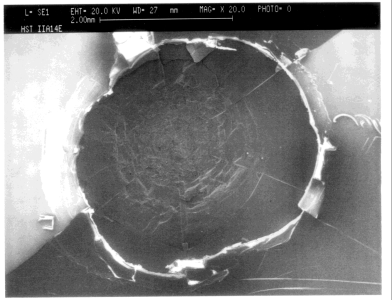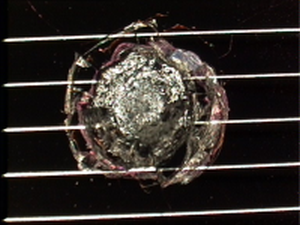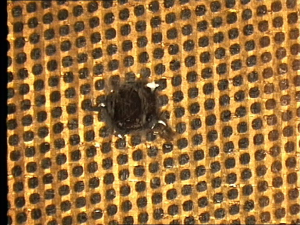Ground based detection (optical or radar) of orbital debris is limited to objects with a diameter larger than a few mm (in low earth orbits or LEO). Dedicated sensors (either active or passive) mounted on a few satellites or manned spacecraft (LDEF, Space shuttle, MIR Station) have provided data on the distribution and possible origin of micrometer sized particles. However, impact pits observed on various materials (not purposely designed as particle detectors) that have been exposed to the space environment provide a wealth of data about the microdebris environment.

Scanning Electron Microscope image of HST Solar Cell
The investigation of LDEF (which was in orbit for 69 months) of the EuReCA and of the solar panels retrieved twice from the Hubble Space Telescope (HST) has been fruitful. Due to the large area-exposure time it has been possible for the first time to describe with a good accuracy the population of particles smaller than 1- 2mm in diameter. Chemical analysis of residues in the impact features is used to discriminate between micrometeoroids and orbital debris.
In the field of space debris, post-flight analysis of hardware is the only way to gain information on the 10 - 1000 micron size range to compare debris models, hypervelocity impact testing and damage equations to actual impacts in space.
The survey of available solar cell impacts has shown that generally, the larger the particles are, the less frequent impacts occur. Residue analysis has shown that most of the impacts (especially the smaller ones) are caused by space debris. In the medium range, meteroids dominate but debris is still a significant factor.
|
Figure 1: Impact crater on HST front side panel |
Figure 2: Impact crater on HST rear side panel |
The data has been compared to the meteoroid model of Grün (Grün et al 1985) and to the space debris models of ESA MASTER and NASA ORDEM. At small crater size, significant decrease of new space debris flux has been identified from 1993 onwards (coninciding with a decrease of solid fuel booster usage following the 1993 peak). At the largest crater sizes, an apparent decrease in flux was observed (when compared to the 2002 analysis) but the precise potential factors have yet to be determined.
Given its important role in space debris research, it is planned to perform additional post-flight analyses when more hardware becomes available.



